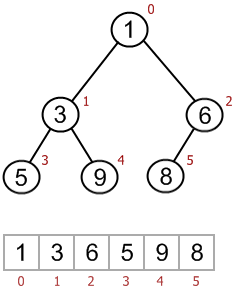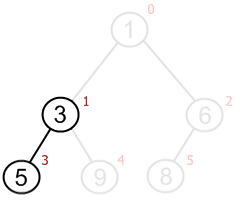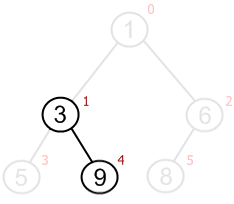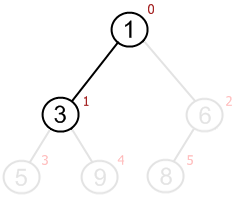Binary heap. Array-based internal representation.
Heap is a binary tree and therefore can be stored inside the computer using links. It gives various benefits; one of them is the ability to vary number of elements in a heap quite easily. On the other hand, each node stores two auxiliary links, which implies an additional memory costs. As mentioned above, a heap is a complete binary tree, which leads to the idea of storing it using an array. By utilizing array-based representation, we can reduce memory costs while tree navigation remains quite simple.
As for the heapsort algorithm, array-based implementation is kind of native.
Mapping heap to array
A heap is stored in array level by level. The topmost level contains root only. It is mapped to the first element of an array (with index 0). Root's children are mapped to the second and third elements and so on. A heap is a complete binary tree, which guarantees, that heap's nodes take up places in the array compactly, making the mapping quite efficient.

Such mapping answers to formulas below:
Left(i) = 2 * i + 1 |
Right(i) = 2 * i + 2 |
Parent(i) = (i - 1) / 2 |
 |
 |
 |
You can see now, that navigation over a heap, mapped to an array, is, actually, very easy.
Code snippets
Java implementation
public class BinaryMinHeap {
private int[] data;
private int heapSize;
public BinaryMinHeap(int size) {
data = new int[size];
heapSize = 0;
}
public int getMinimum() {
if (isEmpty())
throw new HeapException("Heap is empty");
else
return data[0];
}
public boolean isEmpty() {
return (heapSize == 0);
}
…
private int getLeftChildIndex(int nodeIndex) {
return 2 * nodeIndex + 1;
}
private int getRightChildIndex(int nodeIndex) {
return 2 * nodeIndex + 2;
}
private int getParentIndex(int nodeIndex) {
return (nodeIndex - 1) / 2;
}
public class HeapException extends RuntimeException {
public HeapException(String message) {
super(message);
}
}
}
C++ implementation
class BinaryMinHeap {
private:
int *data;
int heapSize;
int arraySize;
int getLeftChildIndex(int nodeIndex) {
return 2 * nodeIndex + 1;
}
int getRightChildIndex(int nodeIndex) {
return 2 * nodeIndex + 2;
}
int getParentIndex(int nodeIndex) {
return (nodeIndex - 1) / 2;
}
public:
BinaryMinHeap(int size) {
data = new int[size];
heapSize = 0;
arraySize = size;
}
int getMinimum() {
if (isEmpty())
throw string("Heap is empty");
else
return data[0];
}
boolean isEmpty() {
return (heapSize == 0);
}
…
~BinaryMinHeap() {
delete[] data;
}
};

| Previous: Binary heap | Next: Inserting an element into a heap |

Contribute to AlgoList
Liked this tutorial? Please, consider making a donation. Contribute to help us keep sharing free knowledge and write new tutorials.
Every dollar helps!